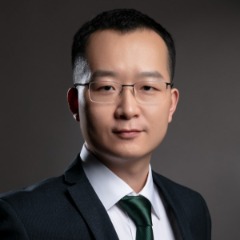
Tenure-track Associate Professor



All living things on Earth depend on the Sun. Photosynthesis maintains the entire biosphere on Earth. As crucial factors for photosynthesis, chlorophylls link the Sun, which is 150 million kilometers away, to the life on Earth. Studying the molecular mechanisms of chlorophyll biosynthesis and photosynthesis is not only to satisfy our curiosity, but also to provide knowledge reserves for solving the many challenges faced by humanity.
Phototrophs adapt to the available light resources in their niche via specific types of photosynthetic pigments and systems. A certain phototroph can only use a limited range of the solar spectrum. By using genetic engineering, we will break through the evolutionary gap so to splice the pigment biosynthetic pathways, to modify the inherent photosystems, and to assemble foreign photosystems in model photosynthetic organisms. We aim to understand the complex assembly mechanisms of photosystems and to obtain engineered ‘broad-spectrum’ photosynthetic bacteria that can make better use of solar energy.
In this long-term project, we attempt to integrate all our knowledge of photosynthesis and use the methodology of genetic engineering and synthetic biology to gradually build a photosystem from the bottom up in heterotrophic microorganisms. At the initial stage we will conduct the project in prokaryotes, mainly E. coli, and later the plan may be extended to eukaryotic microorganisms, such as yeast. This project is extremely challenging, and its ultimate goal is to establish a functional photosystem in heterotrophic organisms that is able to harvest light energy and carry out photochemical reactions in harmony with the energy metabolism of the host.
Chlorophylls are cyclic tetrapyrrole molecules with unique chemical structures including a central magnesium ion and a fifth ring. The formation of the fifth ring causes a color change from ‘red’ to ‘green’, giving rise to the absorption lineshape of chlorophylls. There are two completely different enzymes that catalyze the formation of this ring, one is O2-sensitive and the other depends on O2. The O2-dependent one can be subdivided into three classes in photosynthetic organisms based on whether it requires an auxiliary subunit. This lab studies the biochemical properties of cyclase in combination with structural biological approaches in order to pinpoint the key amino acid residues involved in the reaction, and to elucidate details of the electron transfer process required by the reaction. We will also work on the activity and regulation of cyclase, and its interaction with other chlorophyll biosynthetic enzymes in model photosynthetic organisms.
All living things on Earth depend on the Sun. Photosynthesis maintains the entire biosphere on Earth. As crucial factors for photosynthesis, chlorophylls link the Sun, which is 150 million kilometers away, to the life on Earth. Studying the molecular mechanisms of chlorophyll biosynthesis and photosynthesis is not only to satisfy our curiosity, but also to provide knowledge reserves for solving the many challenges faced by humanity.
Phototrophs adapt to the available light resources in their niche via specific types of photosynthetic pigments and systems. A certain phototroph can only use a limited range of the solar spectrum. By using genetic engineering, we will break through the evolutionary gap so to splice the pigment biosynthetic pathways, to modify the inherent photosystems, and to assemble foreign photosystems in model photosynthetic organisms. We aim to understand the complex assembly mechanisms of photosystems and to obtain engineered ‘broad-spectrum’ photosynthetic bacteria that can make better use of solar energy.
In this long-term project, we attempt to integrate all our knowledge of photosynthesis and use the methodology of genetic engineering and synthetic biology to gradually build a photosystem from the bottom up in heterotrophic microorganisms. At the initial stage we will conduct the project in prokaryotes, mainly E. coli, and later the plan may be extended to eukaryotic microorganisms, such as yeast. This project is extremely challenging, and its ultimate goal is to establish a functional photosystem in heterotrophic organisms that is able to harvest light energy and carry out photochemical reactions in harmony with the energy metabolism of the host.
Chlorophylls are cyclic tetrapyrrole molecules with unique chemical structures including a central magnesium ion and a fifth ring. The formation of the fifth ring causes a color change from ‘red’ to ‘green’, giving rise to the absorption lineshape of chlorophylls. There are two completely different enzymes that catalyze the formation of this ring, one is O2-sensitive and the other depends on O2. The O2-dependent one can be subdivided into three classes in photosynthetic organisms based on whether it requires an auxiliary subunit. This lab studies the biochemical properties of cyclase in combination with structural biological approaches in order to pinpoint the key amino acid residues involved in the reaction, and to elucidate details of the electron transfer process required by the reaction. We will also work on the activity and regulation of cyclase, and its interaction with other chlorophyll biosynthetic enzymes in model photosynthetic organisms.
Chen GE, Hunter CN. (2023) Engineering chlorophyll, bacteriochlorophyll and carotenoid biosynthetic pathways in Escherichia coli. ACS Synth Biol 12: 2236
Chen GE, Adams NBP, Jackson PJ, Dickman MJ, Hunter CN. (2021) How the O2-dependent Mg-protoporphyrin monomethyl ester cyclase forms the fifth ring of chlorophylls. Nat Plants 7: 365-375
Chen GE, Hitchcock A, Mareš J, Gong Y, Tichý M, Pilný J, Kovářová L, Zdvihalová B, Xu J, Hunter CN, Sobotka R* (2021) Evolution of Ycf54-independent chlorophyll biosynthesis in cyanobacteria. Proc Natl Acad Sci USA 118: e2024633118
Chen GE, Hunter CN*. (2020) Protochlorophyllide synthesis by recombinant cyclases from eukaryotic oxygenic phototrophs and the dependence on Ycf54. Biochem J 477: 2313
Chen GE, Canniffe DP*, Hunter CN. (2017) Three classes of oxygen-dependent cyclase involved in chlorophyll and bacteriochlorophyll biosynthesis. Proc Natl Acad Sci USA 114: 6280
Chen GE, Canniffe DP*, Martin EZ, Hunter CN. (2016) Absence of the cbb3 terminal oxidase reveals an active oxygen-dependent cyclase involved in bacteriochlorophyll biosynthesis in Rhodobacter sphaeroides. J Bacteriol 198: 2056
Chen GE, Hitchcock A, Jackson PJ, Chaudhuri RR, Dickman MJ, Hunter CN, Canniffe DP*. (2016) Two unrelated 8-vinyl reductases ensure production of mature chlorophylls in Acaryochloris marina. J Bacteriol 198: 1393